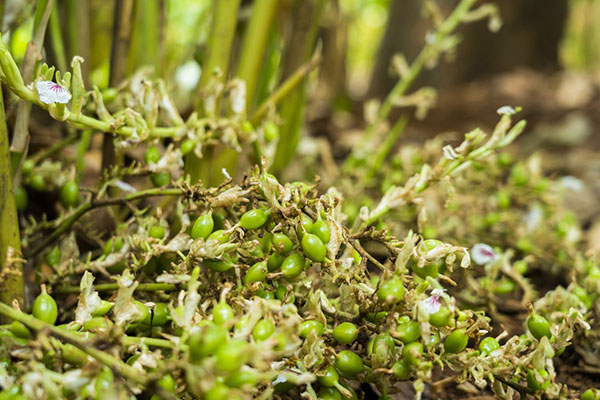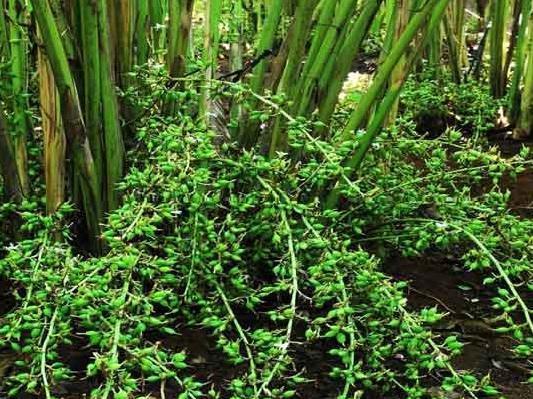As most people have heard, the hill district of Idukki is famous for its cardamom and pepper cultivations. These spices, especially Cardamom have brought in a state of financial stability for the planters and farmers here. Unlike other cultivations, cardamom very much depended on personal care of the plant. Farmers say, even a touch on the plant will bring in more yield. The more you care and protect the plant, the more it yields the crop. The reason why cardamom plantations came into prominence is because of the fungal attacks on other cash crops had to suffer. Cardamom as a crop has never put down a farmer, there have been many instances where there have been drastic price fluctuations, but it has never pulled the farmers into a problem. Cardamom is widely cultivated in Kumily, Annavilasam, Vandanmedu, Nedumkandam, Udumbanchola, Shanthampara and Poopara countys of Idukki district. All these mentioned locations fall on the border belt of the Western Ghats.

Cardamom is a crop very much depended on the climate and luckily Idukki, specially places towards Kumily have a very favorable climate for Cardamom. And that is the reason why you see a lot of cardamom plantation in Thekkady. The crop would require 18 – 23 degree Celsius for the plant to flower and develop into a crop, a few degrees above or lower will result in non flowering, so important is the weather condition for a cardamom plant. The South West monsoon hit the coast of Kerala from the month of June and the rains bring in water and make the land cool which is ideal for cardamom production. The cardamom season starts from June and extends till December. Cardamom grade is based on the length of the crop, it ranges from 5 mm to 8 mm, from June till December the plant yields mostly 8 mm crops, after the winter from January till May (summer) it can go down to 5 mm size.
There are altogether around four different categories of cardamom plants, they are the traditional native variety, Pallakudi, Njallani, Thiruthali, and Mysore Valkla. It was the native variety that was initially cultivated which was not a hybrid variety and the yield was not that great. During this course of time, the spice board of India started a research and development wing at Myladampara in Idukki. That was when Pallakudi was developed as a hybrid variety replacing the Native wild variety of Cardamom, which started to give more yield from the crop. The prices of cardamom in the international market went up which marked a prosperous time for the Cardamom planters of Idukki. Unlike other plantations which result in deforestation, cardamom plantation promotes planing more trees as the cardamom crop requires a lot of shade for better yielding. The Pallakudi variety can be harvested up to five times year, where as other varieties can be harvested only thrice a year.
A revolutionary impact came up when the Njallanil variety of cardamom was introduced. It was developed by a cardamom planter named Reji Njallanil. Today ninety percent of the cardamom plantations are of the Njallanil variety. The Njallanil variety is the highest yielding variety which can be harvested round the year, apart from other varieties Njallanil requires forty percent less shade which gives an advantage to cultivate anywhere where there is soil. Even during summer, if water reaches the crop, the crop will yield, that was not the case with other variety which yield only during the cardamom season. With the support of the spices board and other cooperative societies, cardamom plantation became a very viable and popular plantation crop. The crop yield raised to around five hundred times than what was earlier and the planters of idukki were able to reach the top quality cardamom to the international market. Today approximately seventy thousand to one lakh kilos of cardamom is being auctioned at Cardamom auction center at Puttady Idukki. Apart from all these factors, a lot of employment were generated as part of the cardamom revolution. Around twenty thousand workers from Tamil Nadu climb the hills to Idukki as plantation workers.
As years passed by, there have been many small and large crisis for the planters of Idukki, it was the support extended by the spices board and co operative societies in Idukki that still maintains the such large plantations in Idukki. The farmers did not at time get the real value for the effort put in the cultivation, the mediators and brokers used to take away a large cut to sell the cardamom stock. It was a decade back the spices board intervened into this matter and introduced an online cardamom auctioning system where the planters and farmers could bring their lot and keep it for auction. Registered traders and buyers under the spices park can take part in the auction which brought in a lot of transparency and good remuneration for the planter.
The Monsoon is the harvest period of cardamom, it is during the monsoon that the top quality cardamom is harvested. Cardamom is considered as a blessing for the people of Idukki as this cash crop brought in a lot of prosperity to their land in the hills.

